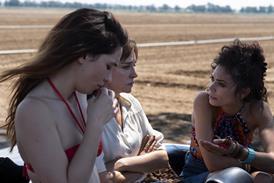Take an Iranian, a Turk, an American and a Frenchman, throw in some Korean funding and start shooting a Japanese film in Tokyo. That is the story behind the critically acclaimed film Cut.
Naderi wanted to make a film in Japan in Japanese about a young Japanese film-maker who comes up with a novel way to pay off his film-making debts. A frequent visitor to Japan, he enlisted the help of both Yuji Sadai, the producer and head of arthouse distribution outfit Bitter’s End, and Tokyo Story, a fledgling Tokyo-based production company run by American Eric Nyari, Turkishman Engin Yenidunya and Frenchman Regis Arnaud. These three young producers in Tokyo Story helped raise the $1.1m budget, partly by selling off Y1m units in the film to 36 private individuals.
Shooting took place over 45 days between August and October 2010 with Hidetoshi Nishijima (Kitano’s Dolls) in the lead role; Naderi edited for six months in Seoul and Busan, using funding he had won from the Busan Film Festival’s Asia Cinema Fund.
Meeting Naderi, Nyari and Yenidunya in Tokyo this week was an invigorating experience and proof that, if there’s a will, there is a way. It also demonstrated to me the power of cinephilia to bring people together. Cut is an homage to great cinema from around the world, not just Japanese cinema and makes a special plea to film-makers to make stories which are both artistic and entertainment. Film, says the lead character played by Nishijima, doesn’t have to lose its artistic value in order to entertain audiences.
This kind of production which happened against the odds with a team drawn from the four corners of the earth shows what can be achieved when the protagonists refuse to see country borders as an obstacle. Nyari and Yenidunya both live in Tokyo and maintain production activities in their respective home countries. Yenidunya, for example, recently produced Turkish drama Toll Booth which was in competition at Istanbul in April and screens at Doha this week.
And Naderi, whose enthusiasm for cinema – his own and everyone else’s – is infectious, was provided with a fixer-translator on the production who spoke Farsi, English and Japanese – a combination of talents which is probably unique in Japan!
I chaired a panel earlier in the week with Naderi and London-based Jeremy Thomas whose own experiences with Japan date back to the early 1980s when he produced Nagisa Oshima’s Merry Christmas Mr Lawrence. Both talked about the challenges and rewards of producing in or co-producing with the Japanese industry, while paying tribute to the extraordinary legacy of its cinema which has spawned masters like Kurosawa, Ozu, Mizoguchi, Naruse, Kobayashi, Suzuki, Teshigahara, Imamura and many others.
Indeed, while I was here, I saw two recent Japanese films which continued that legacy – Sion Sono’s splendid Himizu, which is set against the aftermath of the March 11 earthquake and tsunami, and Hirokazu Koreeda’s enchanting I Wish, an eloquent film about children which refuses to surrender to cliché.
Clearly Japan is often intimidating to foreigners because of language barriers or cultural and business differences, but Cut, Thomas and the universal themes of its cinema are proof that it doesn’t have to be as foreign as it might appear.

























2 Readers' comments